Procedures
Traumatic Dental Injuries
Most traumatic dental injuries occur in children, but people of all ages can be affected. Whether the injury is a result of an automobile accident, a sports mishap, an altercation or a bad fall, the severity and type of injury will determine the treatment necessary. There are a number of common injuries that occur to teeth. Many of them affect the inner soft tissues of the tooth, known as the dental pulp. When the pulp becomes injured or inflamed, root canal treatment may be needed.
Types of Injuries
Chipped teeth account for the majority of all dental traumas. The remaining represents more serious problems, including dislodged and knocked-out teeth. Treatment depends on the type, location, and severity of each injury. When any dental injury occurs, the most important thing is to see your dentist or endodontist immediately. The outcome, or prognosis, for your specific injury often depends on how quickly you see your dentist.
Chipped or Fractured teeth
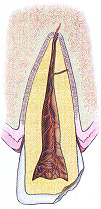
Most chipped teeth can be repaired with a simple filling. Sometimes a chip will expose the pulp of the tooth. Some exposures can be treated by placing a filling over the injured area. Other exposures, however, may require root canal treatment.
Injuries in the back teeth often include fractured cusps, cracked teeth, and the more serious split teeth. Cracks may or may not extend into the root. If the crack does not extend into the root, the tooth can usually be restored by your dentist with a full crown. If the crack does extend into the root and affects the pulp, root canal treatment is usually necessary in an attempt to save all or a portion of your tooth.
Dislodged Teeth
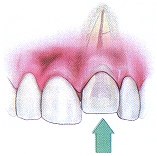
During an injury; a tooth may be pushed into its socket. This can be one of the more serious injuries. Your endodontist or general dentist may reposition and stabilize your tooth. Root canal treatment is usually started within a few weeks of the injury, and a medication, such as calcium hydroxide, may be put into the tooth. A permanent root canal filling will be placed at a later date. You should continue to have the tooth monitored periodically by your dentist to ensure proper healing.
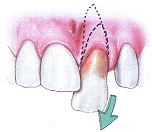
Sometimes a tooth is pushed partially out of the socket. Repositioning and stabilization of the tooth are usually necessary. If the pulp remains healthy, no additional treatment may be needed. If the pulp is injured, your dentist or endodontist may need to start root canal treatment. Medication, such as calcium hydroxide, may be placed inside the tooth, and should be followed by a permanent root canal filling at a later date.
Avulsed Teeth

If a tooth is completely knocked-out of your mouth, time is of the essence. If this type of injury happens to you, pick up your tooth by the crown, or chewing portion. Try not to touch the root. If the tooth is dirty, gently rinse it in water. Do not use soap or any other cleaning agent. If possible, place the tooth back into its socket. Go to the dentist immediately.
If you cannot put the tooth back in its socket, be sure to keep it moist. The less time the tooth spends drying out, the better the chance for saving the tooth. Solutions to keep your tooth moist are available at local drug stores. You can also put the tooth in milk or in a glass of water with only a pinch of salt, or you can simply put it in your mouth between your gum and cheek. Bring your tooth to the dentist immediately.
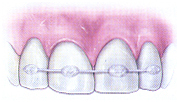
If the tooth has been put back in the socket, your dentist may stabilize the tooth with a splint, and check for any other facial injuries. If the tooth has not been put back into its socket, your dentist will examine the tooth to determine if it is still intact and check for other facial injuries. Your dentist will clean the tooth carefully and place it gently back into the socket. Your tooth may need to be stabilized with a splint for a period of time. Depending on the stage of root development, your dentist or endodontist may start root canal treatment. A medication may be placed in the tooth followed by a permanent root canal filling at a later date. The length of time the tooth was out of the mouth, and the way the tooth was stored before reaching the dentist may influence the type of treatment you receive. You should contact your physician to see if a tetanus booster is necessary.
Root Fractures
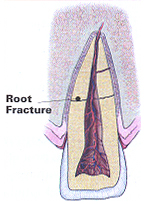
A traumatic injury to the tooth may also result in a horizontal root fracture: The location of the fracture determines the long-term health of the tooth. If the fracture is close to the root tip, the chances for success are better. If the fracture does not result in the two pieces of the root being separated, there is also a better chance for success. However, the nearer the fracture is to the chewing surface of the tooth, the poorer the long-term success rate, regardless of whether the pieces are separated.
Sometimes stabilization with a splint is required for a period of time. If the tissue inside the tooth is damaged, root canal treatment may be needed. A medication may be placed in the canal to prepare the fracture site for the eventual root canal filling.
Do traumatic dental injuries differ in children?
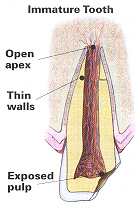
Children’s permanent or adult teeth that are not fully developed at the time of the injury may need special attention. In an immature adult tooth, the tip of the root, called the apex, is open, and the root canal walls are thin. As the tooth develops, the apex closes and the canal walls thicken, An injured tooth may need one of the following two procedures to improve the chances of saving the tooth:
Apexogenisis
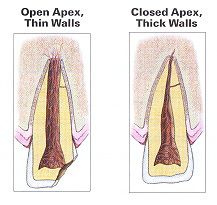
One procedure, called apexogenisis, encourages the root to continue developing as it helps heal the pulp. The injured soft tissue is covered with a medication to encourage further root growth. The apex continues to close, and the walls of the root canal thicken.
If the pulp heals, no additional endodontic treatment may be necessary. The more mature the root becomes, the better the chances that the tooth can be saved. However, apexogenisis is not always successful. A different procedure, called apexification, may need to be performed.
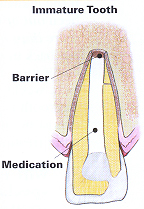
During apexification, the unhealthy pulp tissue is removed. The endodontist places a medication into the root to help a hard tissue form near the apex, or root tip. This hard tissue provides a barrier for the permanent root canal filling. In spite of appropriate treatment, the root canal walls of a tooth treated by apexification will not continue to develop or thicken, making the tooth susceptible to crown or root fractures. Proper restoration will minimize this possibility and maximize protection of your tooth.
Other Injuries
An immature permanent tooth that has been dislodged may require minimal or no treatment other than a follow-up until it has matured. If the tooth is severely dislodged, orthodontic or surgical repositioning a stabilization may be necessary.
If an immature permanent tooth has been out of the mouth for less than one hour, the tooth should be placed back in it’s socket, stabilized, and watched closely by your dentist or endodontist for three to four weeks. During this time, your dentist will look for changes in tooth color, pain, swelling, or loosening of the tooth. If any of these problems arise, an apexification procedure, followed by a permanent root canal filling may be needed. If the immature permanent tooth has been out of the mouth and dry for more then one hour, the tooth may be put back in its socked, filled with medication, and re-evaluated in six to eight weeks. The long-term health of this tooth is generally poor, so your dentist or endodontist may discuss other treatment options with you.
Will the tooth need any special care or treatment?
The nature of the injury, the length of time from injury to treatment, how your tooth was cared for after the injury and your body’s response all affect the long-term health of the tooth. Timely treatment is particularly important with the dislodged or avulsed tooth to prevent resorption. Resorption occurs when your body, through its own defense mechanisms, begins to reject your own hard tooth structure in response to the traumatic injury. You should return to your dentist or endodontist to have the tooth examined at regular intervals following the injury.
